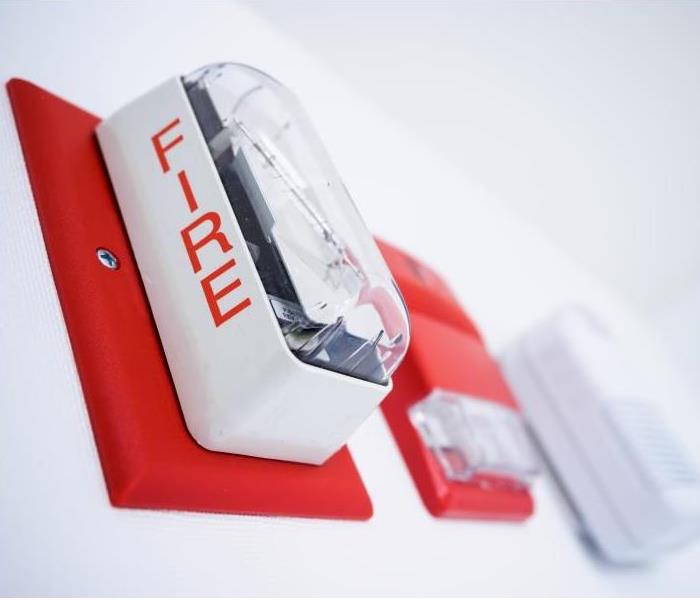Fire Safety Tips for the Workplace
9/27/2019 (Permalink)
 Ensure that smoke alarms and sprinkler systems are installed, working properly, and are not blocked.
Ensure that smoke alarms and sprinkler systems are installed, working properly, and are not blocked.
GENERAL PRECAUTIONS IN THE WORKPLACE
Eliminate workplace fire hazards:
- Damaged electrical outlets, cords, cables, etc.
- Overloaded outlets and circuits
- Combustible objects in unsecured locations (included excessive trash and recycling)—keep these far from electrical equipment!
- Fire exit obstacles
Keep workspace and equipment clean, dry, and well-ventilated, and especially clean of oil and dust.
Prepare for emergencies:
- Follow workspace protocol and guidelines to ensure safety and health; know and understand rules and procedures concerning fire emergencies.
- Ensure that smoke alarms and sprinkler systems are installed, working properly, and are not blocked.
- Conduct regular fire drills.
Employers should follow these workplace fire safety tips:
- Post clear fire escape plans on every level.
- Educate all employees on emergency procedures, exit locations, escape routes, fire alarms and drills, and the use of fire extinguishers.
- Conduct regular drills.
- Install and properly maintain all fire safety equipment.
- Provide for disabled employees.
HAZARDOUS ELECTRICS AND EQUIPMENT
Use only electrical products evaluated by a nationally recognized laboratory (i.e. UL).
Immediately replace damaged, hazardous equipment:
- Look out for anything that appears overheated, smells strange, or delivers an electrical shock.
- Replace all damaged, worn, frayed, or old wires.
Only use three-prong plugs in three-slot outlets (and, similarly: two-slot plug into two-slot outlets).
Equipment that emanates substantial heat should be at least several feet away from combustible surfaces and objects.
- Heaters must include a thermostat control mechanism.
Fires Cause Around $10 Billion In Damage Per Year. Direct property loss due to fires in the U.S. was an estimated $10.6 billion in 2001. (2)100 Firefighters Die Each Year. About 100 firefighters are killed each year in duty-related incidents. (6)
- Know and follow an established emergency and evacuation plan.
- Eliminate potential fire hazards.
- Keep the workspace clean, dry, and free of unnecessary clutter and combustible materials and liquids.
- Maintain clear and easy access to all exits.
- Install and maintain all essential fire safety equipment.
- Follow a no-smoking policy within the workplace.
SMOKE ALARMS: A NECESSITY, NOT AN OPTION
Invest smoke detectors for every room or office.
- Install dual sensor smoke alarms; make sure they contain both ionization and photoelectric smoke sensors.
Test your smoke detectors(and sprinkling system) once a month.
Replace the batteries at least once a year (possible exception: non-replaceable 10-year lithium batteries; still, be sure to test them); many manufacturers also encourage a replacement of the smoke detectors after a decade.
Never disable a smoke alarm.
Consider smoke alarms for the disabled.
- Audible alarms (pauses between the siren wail allow for auditory communication) are available for the visually impaired; visual alarms (with a flashing light or vibrating pad) are available for the hearing impaired.
A NO-SMOKING ZONE IS LESS OF A DANGER ZONE
Keep the workspace a no-smoking zone. If you must smoke, smoke outdoors, and always ensure that you properly extinguish the cigarette in a sand-filled can, or drown cigarette butts and ashes in water.
- Never throw away hot cigarette butts or ashes without attending to them properly.
Be alert and then alert others. If you smell or spot fire or smoke, bring it immediately to attention.
Never smoke where oxygen is being used; for instance, in a hospital room or hallway, or at a nursing home. Even if the oxygen is turned off, the building is much more vulnerable—oxygen can be explosive and will only serve to fan the flames.
IN CASE OF FIRE: FOLLOW THE EVACUATION PLAN
Immediately call 911 in case of a fire.
Know and understand the fire emergency and evacuation plan with these workplace fire safety tips:
- Plan at multiple escape routes from as many locations as possible.
- Check the condition of fire ladders and fire escapes; ladders should be collapsible and have been evaluated by a nationally recognized laboratory (i.e. UL);
fire escapes need to be stable, secure, and easily accessible. - Ensure that windows don’t become obstacles; glass should be openedeasily and screens should be swiftly removed.
Never use the elevator. Walk—don’t run—down the stairs.
If you cannot evacuate,
- Remain calm and put as much distance as possible between yourself and the fire.
- Seal all cracks with wet materials (towels, jackets) to prevent smoke from seeping into the room.
- Wait at the window; shout for help and signal your location by waving the most visible object
- Open the window for air, but try not to break it; you may need to close it if smoke begins to seep in.
Practice; can you feel your way out of the office and building with your eyes closed, or in the dark? Do you know multiple escape routes? Do you know the low windows from which you could jump? Do you instinctively use the back of your hand to feel a door’s heat, and do you remain crouched down as close to the floor as possible?





 24/7 Emergency Service
24/7 Emergency Service